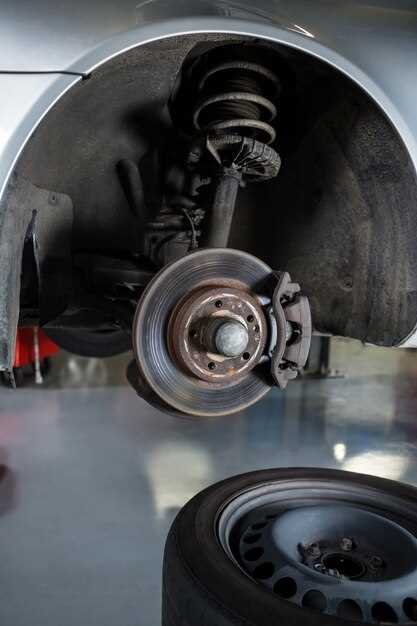The Best Brake Rotors for High-Performance Driving


When it comes to vehicle safety and performance, the importance of high-quality brake components cannot be overstated. Among these components, brake rotors play a crucial role in ensuring effective deceleration and overall handling of your vehicle. Selecting the right set of rotors is essential for both everyday driving and high-performance applications, as they significantly influence braking efficiency, heat dissipation, and pedal feel.
High-performance brake rotors are designed to withstand rigorous conditions, offering superior durability and improved stopping power. This article aims to guide you through the process of choosing the best brake rotors for your vehicle, focusing on key factors such as materials, design features, and compatibility. By understanding these elements, you can make an informed decision that aligns with your driving style and performance needs.
Whether you’re a casual driver seeking enhanced safety or an automotive enthusiast looking to maximize your vehicle’s potential on the track, the selection of brake rotors is a pivotal decision that can impact your overall driving experience. Join us as we explore the intricacies of high-performance brake rotors and what to consider before making your purchase.
Understanding Different Types of Brake Rotors Available
Selecting the right brake rotor for your vehicle is crucial for optimizing braking performance and safety. There are several types of brake rotors available, each designed to cater to specific driving conditions and preferences. Below is an overview of the most common types:
-
Solid (Non-Vented) Rotors:
These are the simplest type of rotor, consisting of a single piece of metal. They are typically used on smaller vehicles and older models.
- Less complex design
- Cost-effective
- Better for light-duty applications
-
Vented Rotors:
Vented rotors have a hollow structure with ventilation channels between two friction surfaces, allowing heat to dissipate more effectively.
- Increased cooling capacity
- Improves overall performance under heavy braking
- Commonly used in most modern vehicles
-
Slotted Rotors:
Featuring parallel slots machined into the surface, slotted rotors enhance the performance by improving heat dissipation and reducing brake fade.
- Better water and gas evacuation
- Increased friction surface area
- Preferred for high-performance and racing applications
-
Drilled Rotors:
Drilled rotors have holes drilled through the surface to enhance airflow, which helps in cooling and improving wet weather performance.
- Reduces weight compared to solid rotors
- Enhances wet weather braking performance
- More prone to cracking under extreme conditions
-
Slotted and Drilled Rotors:
This hybrid design combines the benefits of both slotted and drilled rotors, providing excellent thermal management and performance.
- Maximizes friction and cooling
- Ideal for performance vehicles
- Costly and may require more frequent replacement
In summary, understanding the different types of brake rotors available enables drivers to make informed decisions based on their driving style, vehicle requirements, and budget. Each type serves distinct needs, emphasizing the importance of matching the rotor to your specific situation for optimal brake performance.
Key Features to Look for When Selecting Performance Rotors
When selecting performance brake rotors, there are several essential features to consider to ensure optimal braking efficiency and vehicle safety. First and foremost, rotor material is crucial. High-carbon and vented rotors are popular choices, as they enhance heat dissipation and reduce the risk of warping under high temperatures. Look for rotors made from premium materials, such as composite alloys or cast iron, which offer improved durability and resistance to cracking.
Secondly, consider rotor design. Slotted and dimpled patterns can significantly enhance braking performance by preventing gas and heat buildup between the pad and rotor surface, ensuring consistent contact. Additionally, a floating rotor design can provide better alignment and flexibility, improving overall braking response and reducing noise.
Another important feature is the rotor thickness and diameter. Thicker rotors can withstand greater thermal stress, while larger diameters increase surface area for better heat dissipation and braking force. Ensure the chosen rotor size matches your vehicle’s specifications for compatibility and performance.
Additionally, pay attention to the rotor’s finish. A properly machined or coated surface can minimize brake pad wear and enhance grip. Options like zinc plating can offer corrosion resistance, extending the life of the rotors in various weather conditions.
Lastly, consider the manufacturer’s reputation and warranty terms. Choosing rotors from well-known brands often ensures better quality and support. A solid warranty can also provide peace of mind regarding the longevity and performance of your investment.
How Material Composition Affects Brake Performance
The material composition of brake rotors plays a crucial role in determining their overall performance, durability, and efficiency. Common materials used in the manufacturing of brake rotors include cast iron, carbon composite, and stainless steel, each offering distinct advantages and disadvantages.
Cast iron is the most widely used material due to its excellent thermal conductivity and ability to dissipate heat quickly. This characteristic reduces the risk of brake fade during prolonged use, which is critical for high-performance driving. However, cast iron rotors can be prone to rust and corrosion, especially in wet conditions, which may negatively impact their longevity.
Carbon composite rotors have gained popularity in motorsports and high-performance vehicles due to their lightweight properties and superior heat management. These materials can withstand extreme temperatures without deforming or losing effectiveness. Additionally, carbon composite rotors minimize unsprung weight, which can enhance vehicle handling. However, they tend to be more expensive and may require specialized pads for optimal performance.
Stainless steel rotors offer a unique blend of corrosion resistance and strength, making them suitable for everyday driving situations. They tend to be more durable than cast iron in wet environments, reducing the likelihood of rust formation. Although they may not provide the same level of heat dissipation as cast iron, advancements in design have improved their performance, making them a viable option for performance-oriented street applications.
In summary, the choice of material composition affects crucial factors such as heat resistance, weight, durability, and cost. Understanding these properties can help vehicle owners select the right brake rotors that meet their driving needs while ensuring optimal brake performance.
Comparing Rotors: Cross-Drilled vs. Slotted vs. Solid
When selecting high-performance brake rotors, understanding the differences between cross-drilled, slotted, and solid rotors is essential for optimizing your vehicle’s braking performance. Each type has its unique advantages and potential drawbacks, catering to different driving styles and conditions.
| Rotor Type | Description | Advantages | Disadvantages |
|---|---|---|---|
| Cross-Drilled | Rotors with holes drilled through the surface. |
|
|
| Slotted | Rotors featuring slots cut into the surface. |
|
|
| Solid | Standard rotors without any modifications. |
|
|
Choosing the right rotor type depends on your driving habits, vehicle application, and performance requirements. For aggressive driving or racing scenarios, cross-drilled or slotted rotors may be beneficial, while solid rotors could suffice for daily driving and general use.
Installation Tips for Optimal Performance of Brake Rotors

Installing high-performance brake rotors requires careful attention to detail to ensure optimal functionality. Follow these tips for a successful installation process.
1. Clean the Components: Before installation, thoroughly clean the brake rotors and other components to remove any dust, debris, or grease. Use a dedicated brake cleaner to ensure the surface is free from contaminants that can affect performance.
2. Inspect the Brake System: Examine the entire brake system, including calipers, pads, and hoses, for signs of wear or damage. Replace any worn components to guarantee that the new rotors perform effectively.
3. Use Proper Tools: Utilizing the correct tools is essential. Ensure you have a torque wrench to tighten bolts to the manufacturer’s specifications. Improper torque can lead to uneven wear and rotor warping.
4. Install in Pairs: When replacing rotors, always install them in pairs (front or rear). This helps maintain balanced braking performance and ensures even wear across the system.
5. Follow Manufacturer’s Instructions: Each brand of rotors may have specific installation requirements. Always refer to the manufacturer’s guidelines for installation procedures, recommended brake pad types, and bedding-in processes.
6. Bed-in New Rotors: Proper bedding-in of new rotors is crucial for optimal performance. Follow a recommended bedding procedure by performing a series of moderate stops from a specific speed without coming to a complete stop. This process transfers a layer of pad material to the rotor surface, enhancing friction and reducing brake fade.
7. Check Brake Fluid Levels: Ensure the brake fluid levels are adequate before and after installation. Low fluid levels can lead to reduced braking effectiveness and potential system failure.
8. Monitor After Installation: After installation, monitor the braking system during the initial miles. Listen for any unusual noises and pay attention to pedal feel. If any issues arise, recheck the installation to correct any potential problems.
By following these installation tips, you can maximize the performance and longevity of your high-performance brake rotors, ensuring enhanced safety and driving experience.
Maintaining Your Brake Rotors for Longevity and Safety
Regular maintenance of brake rotors is essential for ensuring both vehicle safety and performance. Proper care can extend the lifespan of your rotors and improve overall braking efficiency. Here are key practices for maintaining your brake rotors.
First, conduct routine inspections to identify signs of wear and damage. Look for uneven surfaces, cracks, or discoloration, which can indicate overheating. Regular checks will help you catch issues early, preventing more significant problems down the road.
It is advisable to clean your brake rotors periodically, as dust and debris can accumulate and affect braking performance. Use a dedicated brake cleaner to remove contaminants without damaging the rotor surface. Cleaning also helps to maintain even wear and prevents rust formation.
Ensure that your brake pads are in good condition, as worn pads can lead to rotor damage. Replace brake pads when necessary, as they are the first line of defense against wear. Using high-quality pads can also enhance the performance of your rotors.
Pay attention to the brake fluid. Old or contaminated fluid can lead to corrosion of the rotors. Flush and replace the brake fluid as part of your vehicle’s regular maintenance schedule to keep the braking system functioning optimally.
Lastly, consider the driving environment and style. Frequent hard braking or driving in harsh conditions can lead to faster wear. Adjusting your driving habits, such as avoiding abrupt stops and using engine braking when possible, can help preserve your rotors for a longer period.
